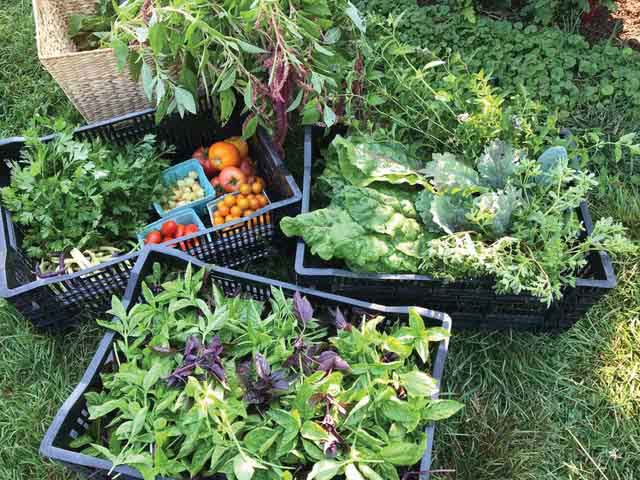By Joyce M. White
Springtime brings extended sunlight, warm breezes, birdsong, pre-season baseball, and the start of salad season, the time when lush fresh greens, herbs, and crisp fresh vegetables are at their height of flavor and freshness, especially when tossed with unctuous and tasty dressings. Keep reading for a bit of history about salads and for some tasty recipes you can try with fresh greens from your local market this spring.
Salads are one of nature’s original fast foods and have been enjoyed for thousands of years. Ancient Romans and Greeks made salads by simply sprinkling greens and vegetables with salt. Consequently, the root word in salad (sal) is Latin for salt. Salad recipes subsequently evolved into more complex varieties served cold or warm; some were tossed with dressing while some were made with layers of vegetables, meats, and fish topped with a drizzling of dressing. As a result, settlers who arrived in the Chesapeake Bay region in the early seventeenth century brought a penchant for salads with them. Fortunately, documentation made by Maryland’s earliest chroniclers reveal, in their words, that the region was blessed with an abundance of greens and vegetable plenteousness [sic], attributable to the fertility of the soil and suitability of the climate. Father Andrew White described this abundance in the 1630s with descriptions of successful harvests of cucumbers, various garden roots and herbs, carrots, cabbages, and radishes from the kitchen gardens established in and around Maryland’s first settlement at St. Mary’s City.
Period recipes offer clues about how historic salads were prepared. A French salad recipe from around 1604 recommends using romaine lettuce, cress, tarragon, mint, pimpernel, and borage and bugloss leaves and flowers. A British recipe from around 1672 by Hannah Woolley describes how to make a warm salad using boiled sorrel, hard-boiled eggs, and raisins dressed with salt, butter, sugar, and vinegar. Woolley also includes recipes for salads made with cold-boiled vegetables. A delicious local salad recipe is found in Mary Randolph’s cookbook from around 1824, “The Virginia Housewife”; this recipe uses a tarragon, mustard, and cooked egg yolk vinaigrette to dress assorted fresh greens, herbs, and hard-boiled egg whites. Finally, no sketch of historic colonial American salads is complete without mention of salmagundi, a hodgepodge of assorted meats, fish, eggs, and onions layered on a plate and dressed with oil and other condiments such as verjuice. Verjuice is an acidic liquid made from unripe sour grapes or crabapples that is similar to, but fruitier and milder, than vinegar. Verjuice was very popular as a substituted for vinegar and was used often during medieval European and colonial American periods.
Give verjuice and some of the following salad recipes a try with this spring’s abundant and plentiful greens.
Recipes
VERJUICE VINAIGRETTE
Ingredients:
1/2 cup verjuice (can be ordered online)
2 teaspoons Dijon mustard
2 tablespoons olive oil
Salt and pepper, to taste
Directions:
Mix together and shake.
Serve on a salad of your choice.
TO DRESS SALAD WITH A TARRAGON MUSTARD VINAIGRETTE
(A modern adaptation of Mary Randolph’s circa 1824 recipe)
Ingredients:
2 eggs
1 tablespoon water
1 teaspoon salt
1 teaspoon powdered sugar
1 teaspoon Dijon mustard
2 tablespoons apple cider vinegar
2 tablespoons tarragon vinegar
2 tablespoons olive oil
Assorted washed salad greens and herbs
5-6 scallions, washed and diced
Directions:
Boil eggs for 10 minutes and then plunge in cold water. Peel eggs and separate yolks and white. Slice or chop the egg whites and set aside; place the yolks in a shallow dish.
Mash the yolks with the water and mix until smooth.
Mix in the salt, sugar, and mustard and then add in the cider vinegar, tarragon vinegar, and olive oil. Whisk briskly until the dressing thickens and becomes creamy.
Pour over salad greens and toss together.
Slice or chop the reserved egg whites.
Garnish the dressed salad with the egg whites and scallions.
SALMAGUNDI
(Based on Richard Briggs’s circa 1794 recipe in “The English Art of Cookery” and other period recipes.)
(Note: Because this dish is meant to be visually appealing, make sure to slice/chop each ingredient in a different shape)
Yield: Serves 4-6
Ingredients:
1 large head of romaine lettuce, washed with leaves separated
4 hard-boiled eggs, separated and chopped
1 cooked boneless chicken breast
Double portion of verjuice vinaigrette (recipe above)
2 pickled herrings (boned) or other fish such as tuna
2 cooked chicken legs
8 ounces of ham, sliced
8 ounces of dried beef or beef salami, sliced
An assortment of colorful garnishes such as pickled beets, celery, apples, etc.
2-3 tablespoons capers (optional)
2-3 anchovies, chopped (optional)
A handful of fresh curly parsley
Directions:
Remove the hearts from the romaine lettuce, chop, and set aside. Place the remaining large green leafy parts on a large serving platter with a lip.
Toss each of the following in 2-3 tablespoon of the verjuice vinaigrette: chopped Romaine hearts, egg whites, egg yolks, and chopped chicken breast meat. Arrange each of these items on top of the leafy romaine lettuce leaves and then arrange the fish, chicken legs, ham, dried beef or salami, and other ingredients of choice on the platter, as well.
Drizzle vinaigrette over all the undressed ingredients, to taste.
Garnish with capers, anchovies, and parsley.
Serve immediately.
Joyce White, a food historian, can be contacted through www.atasteofhistory.net.


